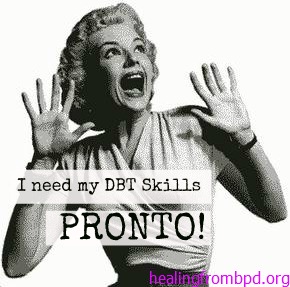Ask Bon: Why does this person idolize me one day and call me “the devil” the next?
Black-and-white thinking is the tendency for a person to believe that events or other people are either “all-good” or “all-bad” in any given situation. People with BPD will often vacillate between these two polar ways of thinking, sometimes about the same event or person. This way of thinking is also known as “splitting.” In the support community, loved ones of BP’s will say that they have been “split-white” (meaning, they are thought to be all good) or “split-black” (thought to be all bad). A person with BPD who thinks in this fashion will have an inability to see “shades of grey” in a situation or relationship. This approach can be extremely frustrating and confusing to the loved ones, because the BP might one day idolize you and then the next day think of you as evil or malevolent. You never know exactly where you stand with the person with BPD.
Black-and-white thinking can lead to “bridge-burning” behavior in which the person with BPD will cut all ties with another person (friend, parent, child or partner) during a period in which the other person is “split-black.” She might say and do things that will destroy the relationship for seemingly no reason. I have seen people with BPD cut all ties with life-long friends over a simple disagreement. Usually, this “simple” disagreement will center upon abandonment fears or fear of judgment. If the person with BPD feels judged or if rejection or abandonment is seemingly imminent, she is likely to “leave you before you leave me” effectively running away from the “evil” person and damaging any additional hopes of a continued relationship. Sometimes a person with BPD will be regretful of the destruction, because the other person has returned to being all-good.
A BP is not immune from turning this black-and-white thinking upon herself, one day thinking that she is “all-good” (even god-like) and the next self-flagellating for being evil, broken, sinful and bad. Since shame is involved the “splitting black” of herself is total: she didn’t just DO something bad, she IS bad. This pattern can lead to suicidal ideation because, if she is a “bad person”, there is no reason to live. She can never be redeemed.
Some words that are hallmarks of black-and-white thinking are “always” and “never”, “good” and “bad” (or evil),“everything” and “nothing” and other polar opposite words. Black-and-white thinking is also known as “all-or-nothing” thinking.
One way to combat black-and-white thinking is to come up with past situations in which the object of the thinking acted differently or in which the BP thought differently of the person. The “dialectical” part of DBT specifically speaks to black-and-white thinking. Dialectical philosophy takes two polar opposites (called the thesis and antithesis) and synthesizes them into a resolution – called the synthesis. DBT uses acceptance and change as opposites and tries to synthesize the two so that the BP begins to consider shades of grey in a situation and in herself. DBT operates under the premise that there are several “dialectical dilemmas” at work in the mind of a BP. These are opposites modes of thinking and behavior, and the BP will swing wildly between them. One purpose of DBT is to gain a balance between the polar opposites. The dialectical dilemmas are:
- Unrelenting Crisis (biological) – Inhibited Experiencing (social): the “balance” achieved through “Wise Mind” (for Unrelenting Crisis) and “emotional experiencing” (for Inhibited… )
- Active Passivity (biological) – Apparent Competence (social): the “balance” achieved through “Problem Solving” (for Active Passivity) and “Accurate Expression” (for Apparent… )
- Emotional Vulnerability (biological) – Self Invalidation (social): the “balance” achieved through “Emotional Modulation” (for Emotional… ) and “Self Validation” (for Self… )
The notes here are based on my interpretation of the dilemmas and are not attributed to Linehan or any other DBT expert directly. I made this interpretation from a diagram of the dilemmas that I have posted in my Internet group.

